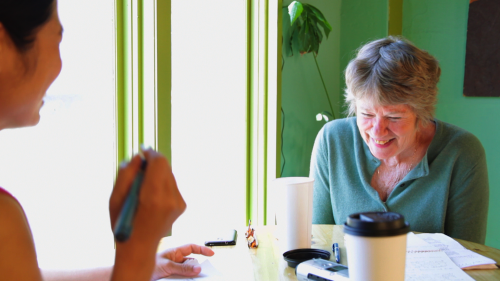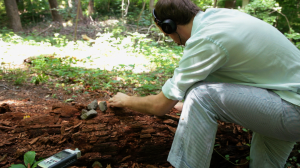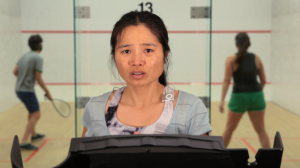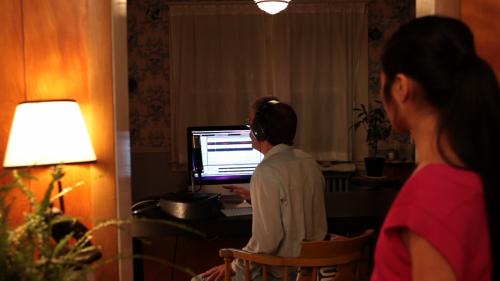Film
DAREDEVILS
 Stephanie Barber’s movie DAREDEVILS (2013, premiering at the NY Film Festival next Thursday) is—among the many things that it is—a feature length narrative, and in itself an act of daredevilry. It is not an experimental film—that is, it doesn’t have much in common with the “traditional experimental film”—and it is a “movie” in the sense that it contains character development, relationships, dialogue, recognizable images, movement, music, and storytelling. The traditional three-act structure, however, is rearranged, subverted, and therefore not present to comfort you, and what’s more, the story demands your participation—and a rather rigorous participation. Like all stories, this one is a mystery, and you might say the involvement of the viewer in this story is similar to the mystery in which the audience sets out to solve the mystery. If reading the clues presented here will lessen your enjoyment of the movie, you know who you are and should stop reading now. Otherwise, read on.
Stephanie Barber’s movie DAREDEVILS (2013, premiering at the NY Film Festival next Thursday) is—among the many things that it is—a feature length narrative, and in itself an act of daredevilry. It is not an experimental film—that is, it doesn’t have much in common with the “traditional experimental film”—and it is a “movie” in the sense that it contains character development, relationships, dialogue, recognizable images, movement, music, and storytelling. The traditional three-act structure, however, is rearranged, subverted, and therefore not present to comfort you, and what’s more, the story demands your participation—and a rather rigorous participation. Like all stories, this one is a mystery, and you might say the involvement of the viewer in this story is similar to the mystery in which the audience sets out to solve the mystery. If reading the clues presented here will lessen your enjoyment of the movie, you know who you are and should stop reading now. Otherwise, read on.
DAREDEVILS is framed by a monologue, a voiceover, a one person “chorus,” about the Monarch butterfly, the most common of animals—who, if you dig deeper, become increasingly bizarre—whose cross-generational migration remains a mystery to science. The extent in which you interpret this metaphorically depends on—as with all aspects of the journey—the depth of navigation you choose. After she’s done with the Monarch, she—The Chorus—turns to us, The Audience, and says: “You are waiting for the story…” and then: “And who am I? Oh, yes, right. I will be you, watching. I am you.”
 Like all stories, this one is a portrait, and in this case, a portrait of several characters. It begins as a meeting between a young woman, “The Writer,” who is interviewing an older woman, “The Artist.” This interview—which takes place in a café, pretty much in real time—is the bulk of the movie. It is broken up, periodically, by short, unexplained segments depicting a young man, “The Musician,” making percussive, rhythmic sounds somewhere outdoors, in what looks like a ruins, among manmade concrete and steel structures that have been taken back to the earth by nature and time. He is apparently recording the noises he makes—metal against rock, rock against wood, etc.—with a field recorder. These short sections punctuate the interview, but at this point have no explanation or apparent reason for existing.
Like all stories, this one is a portrait, and in this case, a portrait of several characters. It begins as a meeting between a young woman, “The Writer,” who is interviewing an older woman, “The Artist.” This interview—which takes place in a café, pretty much in real time—is the bulk of the movie. It is broken up, periodically, by short, unexplained segments depicting a young man, “The Musician,” making percussive, rhythmic sounds somewhere outdoors, in what looks like a ruins, among manmade concrete and steel structures that have been taken back to the earth by nature and time. He is apparently recording the noises he makes—metal against rock, rock against wood, etc.—with a field recorder. These short sections punctuate the interview, but at this point have no explanation or apparent reason for existing.
The interview unfolds with The Writer recording on a similar digital recorder placed on the café table in front of The Artist, both of them with coffee, pens, and notebooks. They are both writers, we eventually learn, for whom the written word is their first means of expression—the foundation of their work—but also desire to move away from the word into other forms of expression. As their meeting begins, the writer expresses that she is in awe of the artist, a “fan,” but that uncomfortable dynamic soon shifts to leveler ground, to a conversation between two people who understand each other, exploring ideas. When the artist eventually reveals that she has read the writer’s stories—to decide if she would do the interview—it is perhaps the ultimate compliment. We get the sense that the writer could be a younger version of the artist, maybe, or at least that there is a cross-generational connection.
The writer is on assignment, has an editor she’s working for, and is in work mode. The artist says her time is precisely parceled out, which suggests other scheduled interviews and limited time in the city. Still, the artist makes sure she is understood, and each topic of discussion is explored thoroughly. The interview continues as a cataloguing of the artist’s works, which we—the audience, eavesdropping from a nearby café table—are hearing about for the first time. We have to struggle to keep up, to put the puzzle pieces slowly together, but soon we’ve constructed a grand and mysterious body of work. This is the day we went out for a cup of coffee and struck gold—the ultimate conversation to listen in on—and while we’ve never heard of this artist, and don’t know this writer, by the time the interview concludes, it’s as if we’ve made a couple of new friends.
Throughout the interview, they discuss a number of the artist’s works, which all sound pretty incredible. First, there is a hologram “film,” which is a gallery installation where the viewer passes through a space that’s filled with life-size, holographic photographs. Then there’s a hotel room with magnetic floor, ceiling, and walls in which a magnetic bed is placed in the middle with the polarity adjusted so it hovers in the air and the viewer can lie on the bed and literally levitate. Another work, named the “Smellodium,” is an installation where the viewer moves through a controlled environment where a variety of smells are parceled out to create a kind of olfactory symphony. Finally, they discuss a work in which some kind of sky writing places words at various, significant locations to create enormous sky poems.
The discussion of each of these works brings up topics central to and illustrated by the works—and at the heart of the artist’s oeuvre. The discussion of scale, first and foremost—the way scale is an idea of its own: “Scale as a component of a piece cannot be overlooked as a means by which a thing is expressed… it IS also what is being expressed.” The artist refers to the manifestation of daydreams, and the work of magic, and gift giving. Then there is the audience’s participation in the work and “surrendering to the audience’s organization,” and letting go of control vs. the ultimate intention of the artist. The relationship of the work to dance, and the ways the works become a performance that the viewer becomes a part of. The way we move through time. The humbleness—and arrogance—of allowing your audience to draw their own conclusions. Trust, and surrender—the audience understanding the work, or not, and the frustration, or gratification of the artist. The game of believing in art … the ultimate belief in art … the work of the artist as daredevilry.
At some point in her life the artist decided to move to the Everglades, in part to get away from the structure of the art world, but also because of her interest in animals and nature. This initiates a discussion of the idea of creating art in a vacuum or the need for an audience, and the fairytale-like desire for acceptance, and the need for love, and the sorrow that must accompany that—the way connection with another person always has a side that is tragic. This is where their conversation turns to the writer’s work, and the dynamic of their conversion changes—they are coming together, perhaps becoming friends, or even as one mind. And then suddenly, the artist realizes that her time is up and gets up abruptly, apologizes—whisks everything into her bag, almost comically—and then she is gone. All traces of her have disappeared—even the to-go coffee cup and its black plastic lid are gone. The vacuum created by her exit is palpable.
 The next scene is at a gym where the writer presumably goes after the interview, perhaps to reflect on, or recover from, her conversation with the artist. We see her now, head-on, close up, while on a treadmill, as if watching through one-way glass. Behind her is a glassed-in racquetball court where a man and woman play. As the writer engages her MP3 player, instead of exercise music there is a monologue by another woman, a “Daredevil”—and whether this is an interview or a performance we do not know. But we listen, now, and watch the writer as she listens.
The next scene is at a gym where the writer presumably goes after the interview, perhaps to reflect on, or recover from, her conversation with the artist. We see her now, head-on, close up, while on a treadmill, as if watching through one-way glass. Behind her is a glassed-in racquetball court where a man and woman play. As the writer engages her MP3 player, instead of exercise music there is a monologue by another woman, a “Daredevil”—and whether this is an interview or a performance we do not know. But we listen, now, and watch the writer as she listens.
The voice we hear begins by listing professions (skydiver, racecar driver, on and on) that might be considered daredevils (persons on treadmills and racquetball players being conspicuously absent from the list—not to mention artists and writers). We soon understand she is a literal daredevil, a person who does stunts, presumably for money, but also because it’s what she does to feel alive. Almost immediately she addresses the question of whether she has a death wish, which she denies, though she compares her compulsion to take these risks, to do the “tricks” she does, with the compulsion of a Jack Russell terrier who chews anything in sight if not engaged. The danger of these stunts, it seems, to her, is about feeling alive.
After reflecting on her history as a daredevil, she recalls a particular stunt that involved hanging from a bridge while enveloped, cocooned, in Saran Wrap, and how, in this particular instance, it crossed her mind to let herself succumb to it, to give up and perish. A fleeting thought only, she says, but her recollection of this is harrowing, and now we notice that it has moved the writer to tears—an expression of full-fledged sorrow. At this point, we want to know what we cannot know: is there a possibility that this daredevil has died—perhaps while going further, later—and this might be the last document of her existence? Or maybe this is one of the writer’s stories? Or maybe something that will inform one of her stories.
The final scene is of the writer entering a warm, pleasant space with the ease that says this is home. We immediately notice a man singing what sounds like a traditional folk or gospel song, the lyrics asking questions of rivers, birds, and children. The writer walks through the space until we see her looking in on the man singing, and now we can guess that it is the man who was seen earlier making percussive music outdoors. He sits in front of a computer with headphones, presumably in the process of creating a song. The writer looks in on him momentarily, and from their lack of greeting we feel an intimacy, a closeness that makes greeting unnecessary. But also, possibly—we wonder, we don’t know—a severing, a gap, between two intimate people who live together but no longer have the connection they once had.
 As we wonder, and listen to the song, the writer walks through the house, looks out a window on the night sky, then leaves the frame as the camera looks out the window onto the backyard where she again joins the scene. Then she begins to move her body to the music, at first absently, it seems, but enveloped in it. The song we hear continues to evolve: the percussion recorded earlier is added, mulittracked, and the sung verses continue to repeat. The dance evolves as well, from what looks like it could be the simple relaxation, progressing to structured performance—sometimes with the music, sometimes against it. The dance is at once freeform and formal—at once joyful and sorrowful, comic and tragic.
As we wonder, and listen to the song, the writer walks through the house, looks out a window on the night sky, then leaves the frame as the camera looks out the window onto the backyard where she again joins the scene. Then she begins to move her body to the music, at first absently, it seems, but enveloped in it. The song we hear continues to evolve: the percussion recorded earlier is added, mulittracked, and the sung verses continue to repeat. The dance evolves as well, from what looks like it could be the simple relaxation, progressing to structured performance—sometimes with the music, sometimes against it. The dance is at once freeform and formal—at once joyful and sorrowful, comic and tragic.
Finally, another vocal track is added, contrasting but also in congress with the melodic verses. It’s a repeated chant as well, but lyrically a generation apart from the earlier song—almost “punk rock” in nature—a repetition of this line: “You want to be in love just so you can tell yourself you’re not going to die, but you are going to die.” And finally, as if to lessen the harshness of that sentiment—or maybe to rub it in—there is a kazoo.
Because all stories are love stories, this one is too. The story continues, but the movie comes to an end. The credits roll, the song ends, and we are left with the faroff sounds of cars on the highway… but we are again joined by The Chorus, from earlier: “I forgot to tell you that the risks these butterflies incur is the assertion that value exists, and agreeing to play the game.” She has the last word, but I have the last word here, and, like I said, this article must fail. An article, by definition, reduces, compartmentalizes… but this movie does the opposite: it expands, opens up. Instead of solving mysteries it creates an entire mysterious world. Also, I think I have expressed that this movie is sad, but did I say that it is funny? I think I said that it is a feature film, and a movie, but did I forget to say that it’s also a symphony? And a poem?
Randy Russell’s kaleidoscopic resume includes acting, producing, and writing for films and plays; exhibiting art; writing and distributing ‘zines; publishing poems, articles and stories; writing songs and playing in bands; owning and operating a punk music and ‘zine store, and writing in a variety of personas for over fifty online journals. Russell’s acting career includes starring roles in American Job (1996), Soulmate (2000), and Modus Operandi(2009). The Pool (2007), directed by Chris Smith, was inspired by a short story of the same name from Russell’s short story collection, Nine Lies. His writing has been included in The Factsheet Five Zine Reader, American Barricade, Gam, Nerve House, and The Utne Reader. He has recently published a short novel, Nine Lives. Follow him on twitter @randysrussell.
Tags: DAREDEVILS, randy russell, stephanie barber

left this post earlier expecting to come back to millions of comments. this is very exciting and i really hope to see it soon. stephanie barber is fascinating.
yes
tinyurl.com/l3cselt
vvv
tinyurl.com/l3cselt